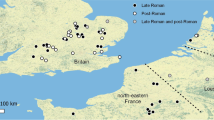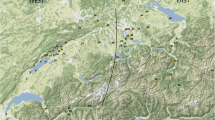Abstract
This paper discusses the importance of economic specializations in banana farming and cattle pastoralism in eastern Africa's Great Lakes region. I present comparative linguistic evidence for the careers of these two socially and economically important food sources. Next, I review some recent archaeological work on pastoralism and Later Iron Age pottery traditions. A final section considers some of the forces that shaped the choices of some Lakes Africans to take up more intensive forms of banana farming and/or pastoralism.
Résumé
Cet article discute de l'importance des spécialisations économiques dans la culture de la banane et l'élevage du bétail dans la région des grands lacs d'Afrique orientale. J'y présente des témoignages linguistiques comparatifs sur les trajectoires de ces deux sources alimentaires socialement et économiquement importantes. Ensuite, j'examine des travaux archéologiques récents sur l'élevage et les traditions de la poterie de la fin de l'âge de fer. Une dernière section étudie certaines des forces qui ont orienté le choix par certains africains de la région des lacs d'adopter des formes plus intensives de culture de la banane et/ou d'élevage.
Similar content being viewed by others
References
Anonymous. 1940.An English-Luhanga Vocabulary. Butere: Church Missionary Society.
Baitwababo, S. R. 1969. Bashambu rule in Rujumbura, 1780–1920. InNgano (ed. B. G. McIntosh): pp. 1–25. Nairobi: East African Publishing House.
Berger, I. and C. Buchanan. 1976. The Cwezi cults and the history of Western Uganda. InEast African Culture History (ed. J. T. Gallagher): pp. 43–78. Syracuse, N.Y.: Maxwell School of Citizenship and Public Affairs.
Berger, I. 1980. Deities, dynasties, and oral tradition: the history and legend of the Abacwezi. InThe African Past Speaks (ed. J. C. Miller): pp. 61–81. Folkestone: Dawson.
Berger, I. 1981.Religion and Resistance: East African kingdoms in the precolonial period. Tervuren: Musée royal de l'Afrique Centrale.
Blakney, C. P. 1963.On ‘Banana’ and ‘Iron’: linguistic footprints in African history. M.A. thesis, Hartford Seminary, Auburndale.
Cirhagarhula, B. 1981. Mythe hamite, formations étatiques et acculturation interlacustres. InLa civilisation ancienne des peuples des grands lacs, Colloque de Bujumbura, 4–10 septembre 1979: pp. 218–43. Paris and Bujumbura: Karthala and Centre de Civilisation Burundaise.
Chrétien, J-P. 1981. Pouvoir d'état et autorité mystique. L'infrastructure religieuse des monarchies des grands lacs.Revue française d'Histoire d'Outre-Mer 68:112–30.
Chrétien, J-P. 1983.Histoire rurale de l'Afrique des Grands Lacs. Paris: Karthala.
Chrétien, J-P. 1985. L'empire des bacwezi, la construction d'un imaginaire géopolitique.Annales: économie, société, civilisation 40:1335–77.
Chrétien, J-P. 1986a. Confronting the unequal exchange of the oral and the written. InAfrican Historiographies, what history for which Africa? (eds B. Jewsiewicki and D. Newbury): pp. 75–90. Beverly Hills: Sage.
Chrétien, J-P. 1986b. Roi, religion, lignages en Afrique orientale précoloniale: royautés sans état et monarchies absolues. InLes Monarchies (ed. E. Le Roy Ladurie): pp. 115–33. Paris: Presses Universitaires de France.
Cohen, D. W. 1972.The Historical Tradition of Busoga: Mukama and Kintu. Oxford: Oxford University Press.
Connah, G. 1991. The salt of Bunyoro.Antiquity 65:479–94.
d'Arianoff, A. 1952.Histoire des Bagesera, souverains du Gisaka. Bruxelles: Institut royal Coloniale Belge.
David, N., J. Sterner and K. Gavua. 1988. Why pots are decorated.C.A. 29:365–89.
De Langhe, E. 1961. La taxonomie du bananier plantain en Afrique équatoriale.Journal d'agriculture tropicale et botanique appliquée 9:417–49.
De Langhe, E. 1969. BananasMusa spp. InOutlines of Perennial Crop Breeding in the Tropics (eds F. P. Ferwerda and F. De Wit): pp. 53–78. Wageningen.
Ehret, C. 1988. The East African interior. InAfrica From the Seventh to the Eleventh Century (ed. M. El Fasi): pp. 616–42. Paris: UNESCO.
Vidal, C. 1969. Le Rwanda des anthropologues ou le fétichisme de la vache.Cahiers d'Etudes Africaines 9:384–401.
Wainwright, G. A. 1952. The coming of the banana to Uganda.U.J. 16:145–7.
Waller, R. 1985. Ecology, migration, and expansion in East Africa.African Affairs 84:347–70.
Webster, J. B. 1979. Noi! Noi! Famines as an aid to interlacustrine chronology. InChronology, Migration and Drought in Interlacustrine Africa (ed. J. B. Webster): pp. 1–38. Halifax: Longman.
Wrigley, C. C. 1989. Bananas in Buganda.Azania 24:64–70.
Rights and permissions
About this article
Cite this article
Schoenbrun, D.L. Cattle herds and banana gardens: the historical geography of the western Great Lakes region,ca AD 800–1500. Afr Archaeol Rev 11, 39–72 (1993). https://doi.org/10.1007/BF01118142
Issue Date:
DOI: https://doi.org/10.1007/BF01118142




